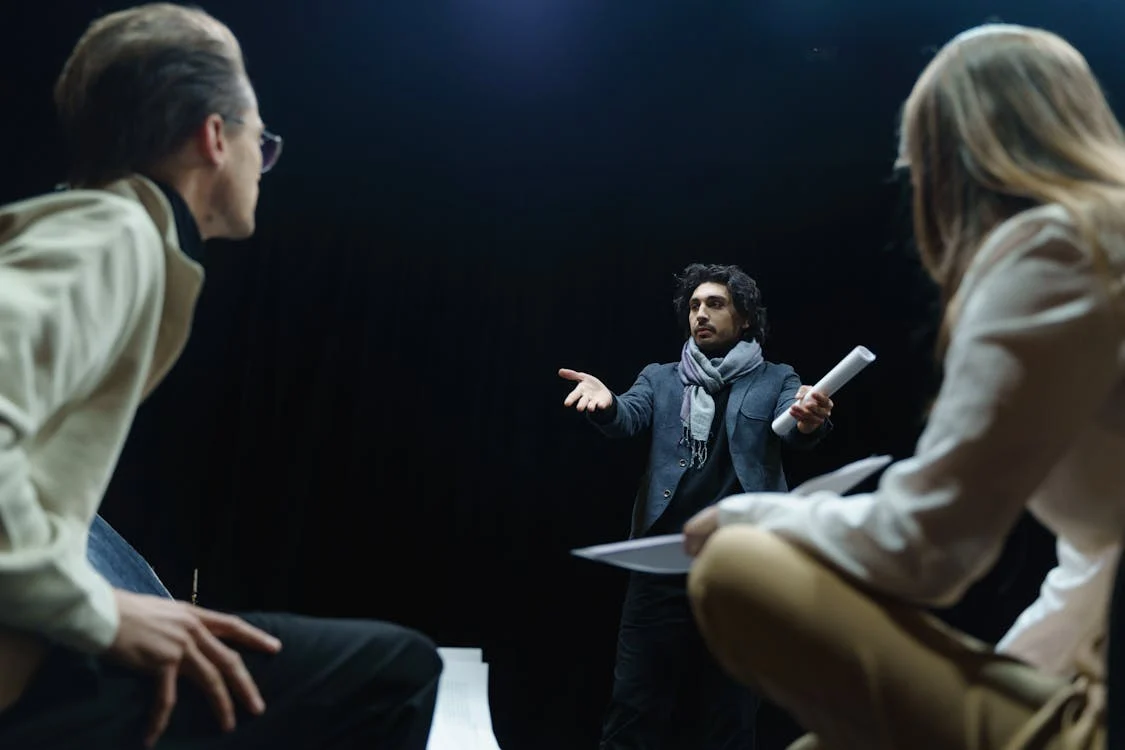What Are the 4 C’s of Acting?
Mastering these four elements can help you build a lasting career
(By Tonya Tannenbaum)
 (Photo: Cottonbro | Pexels)
(Photo: Cottonbro | Pexels)
There are a set of core principles that can help guide an actor’s approach to their craft. These principles, often referred to as the “4 C’s of Acting,” are Character, Commitment, Connection, and Creativity. Mastering these four elements can help you deliver compelling performances and build a lasting career.
Character
Understanding the Role
The first “C” of acting is Character. At its core, acting is about stepping into the shoes of another person and bringing that character to life. This requires a deep understanding of the character’s background, motivations, and emotional journey. To convincingly portray a character, an actor must study the script thoroughly, analyze the character’s relationships, and consider how the character changes throughout the story.
Creating a Backstory
Building a character requires developing a backstory, even if it’s not explicitly mentioned in the script. This involves imagining the character’s life before the events of the play, film, or television show. By creating a detailed backstory, actors can make informed choices about how their character behaves, speaks, and interacts with others, adding depth and authenticity to their performance.
Physical and Vocal Choices
Characterization also involves making specific physical and vocal choices. This includes considering how the character walks, their posture, their speech patterns, and any distinctive mannerisms. These choices should be consistent with the character’s background and personality, helping to create a fully realized and believable portrayal.
Commitment
 (Photo: Cottonbro | Pexels)
(Photo: Cottonbro | Pexels)
Embracing the Role Fully
Commitment is the second “C” of acting, and it’s about fully dedicating yourself to the role, no matter how challenging or uncomfortable it might be. This means embracing the character’s emotions, actions, and experiences without holding back. Whether the role requires extreme physicality, intense emotional scenes, or difficult dialogue, commitment ensures that the actor delivers a performance that is truthful and powerful.
Preparation and Rehearsal
Commitment also involves rigorous preparation and rehearsal. Before stepping onto the stage or in front of the camera, an actor must invest time in learning lines, rehearsing scenes, and exploring different interpretations of the character. This level of dedication helps build confidence and ensures that the actor is ready to respond to any challenges that arise during a performance.
Endurance and Resilience
Acting can be physically and emotionally demanding. Commitment requires endurance and resilience, especially during long rehearsals, multiple takes, or challenging scenes. An actor’s ability to stay focused, energized, and committed to their role, even under difficult circumstances, is a testament to their professionalism and dedication to their craft.
Connection
 (Photo: Cottonbro | Pexels)
(Photo: Cottonbro | Pexels)
Building Relationships with Other Characters
The third “C” of acting is Connection, which is essential for creating believable relationships on stage or screen. Acting is a collaborative art form, and the chemistry between actors can significantly impact the success of a performance. Building strong connections with other characters involves active listening, responding authentically in the moment, and being attuned to the dynamics of the scene.
Engaging with the Audience
Connection extends beyond the actors on stage or set—it also includes connecting with the audience. A compelling performance draws the audience into the world of the story, making them feel emotionally invested in the characters and their journey. This connection is achieved through the actor’s ability to convey the truth of the character’s emotions and to engage with the audience’s imagination.
Emotional Honesty
To connect with both other actors and the audience, emotional honesty is crucial. This means being vulnerable and allowing yourself to fully experience the character’s emotions, rather than simply pretending or indicating. Genuine emotional connection can create powerful, memorable performances that resonate deeply with audiences.
Creativity
 (Photo: Cottonbro Studio | Pexels)
(Photo: Cottonbro Studio | Pexels)
Bringing Something New to the Role
The fourth “C” of acting is Creativity, which involves bringing originality and inventiveness to your performance. While scripts and directors provide guidelines, it’s up to the actor to interpret the role in a way that’s fresh and unique. Creativity allows an actor to make bold choices, explore new approaches to a character, and infuse their performance with personal insight and imagination.
Improvisation and Adaptability
Creativity also encompasses the ability to improvise and adapt. Not everything goes according to plan during a performance—props can malfunction, lines can be forgotten, or unexpected challenges can arise. A creative actor can think on their feet, improvising solutions and staying in character even when things don’t go as expected. This adaptability is a valuable skill in both live theater and film, where spontaneity can lead to unexpected moments of brilliance.
Exploring Different Perspectives
Acting is about exploring the human experience from different perspectives. Creativity involves the willingness to take risks, challenge assumptions, and explore characters who are very different from yourself. By approaching each role with an open mind and a sense of curiosity, actors can discover new depths in their characters and deliver performances that are both innovative and truthful.



